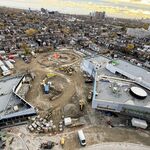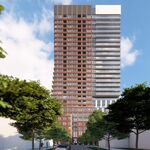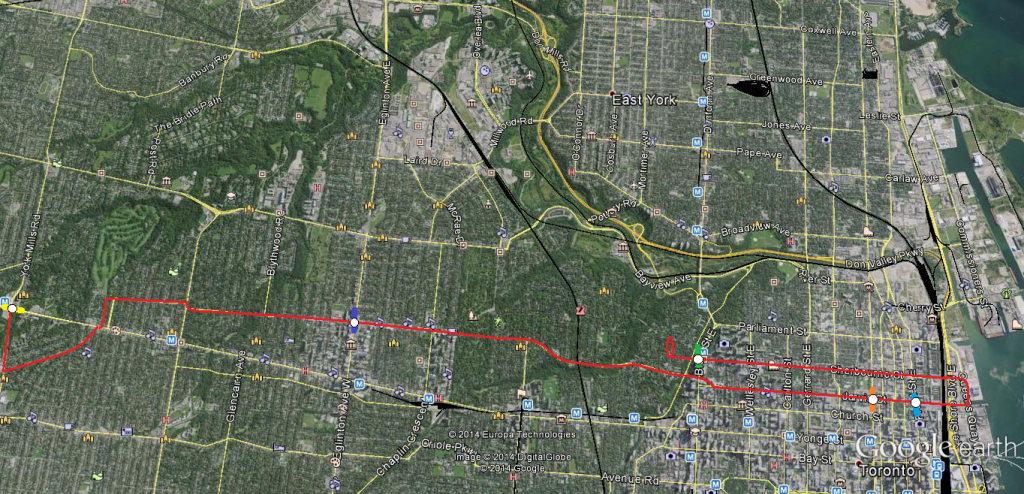The Midtown corridor is tricky IMO, because it relies so much on freight operations being moved elsewhere. Unlike sections of the Milton line through Mississauga, widening the corridor through Toronto would be quite difficult. That isn't to say that widening through Mississauga won't be a challenge, but through Toronto would be harder.
According to Google Earth, I see lots of space where they seemed to have had provisions (or discontinued) a 4th track in the downtown section of this corridor. You have to get further away from downtown to see some really thorny stuff. Most difficult part though is the parts passing over Dufferin, it seems. Big tangle and trainyard west of Dufferin could be a challenge to reorganize to prevent crossings with GO RER. Give 2 tracks to CN and 2 tracks to GO, and that's enough to run electric GO RER bidirectionally across midtown while CN being able to do the same. Throw a few bones to CN like improved track and signalling, to allow them to give up some sections of 3-tracks (to free up a track for GO) while still moving freight trains at higher speed in exchange for letting Metrolinx occasionally use these improved track as passing track in case of GO RER stalls, etc. Biggest challenge will be finding places for platforms at stations and preventing crossings with freight tracks -- these will be the biggest issue. An expensive underground section may be required to bypass the trainyard if no simple way to avoid freight crossovers. If you simply do underground GO track along some "challenging" sections (not all), you can still share the corridor between CN and GO. No need to move freight elsewhere. But altogether, a solvable problem, and corridor width seems to be less of a problem than this (except the tightness I see near Dufferin, but I think that still can fit 4 track). Midtown is an easier problem than some of your fantasy GO routes, so I think Midtown should be reconsidered.
I spent half an hour exploring Google Earth Online, scrolling the CN track. Ironically, it seems easier to share the CN corridor with GO during the downtown section (4-tracking it) than through the big yard past Dufferin (The Junction, near Dufferin Park) due to lots of crossovers. That's where I think a section GO Tunnel will be needed to prevent crossing over CN tracks. Once additional track is added, CN can use the central two tracks and GO can use the outer tracks (for easier platform access), until it reaches the complex parts, where the GOtrains starts entering an underground tunnel to go under CN tracks/trainyards, and re-emerging somewhere past. This would be a expensive multi-hundred-million project to solve a thorny problem, but allows CN to keep using the corridor, while giving us yet another crosstown line within walking distance of those well north of Bloor. In the downtown and near-downtown there appears to be some sections of trail on the midtown line that was formerly extra track that's since been removed, but there's padding between that and the still-used tracks. If the overpasses are rebuilt, the trail can be kept but narrowed while being pushed further south in order to re-add a track. GO would have to appease that, but would at least accomplish the Midtown line while not kicking freight off the corridor. Some really complex overpass situations occur, but it looks like most expropriation can be avoided in the midtown corridor, with a creative package of slight north-south shifting of track, 4-tracking, walking-trail-shifting, usage of existing ROW width, and one or two (reasonably short) GO RER tunnel sections to bypass some unavoidable freight crossovers. You might know some things that I don't know, and I am missing some things. But it seems like Midtown is a more cheaply solvable problem than some of the fantasy routes on your map.
Once enough relief is added (DRL, SmartTrack), the crosstown line with a lot of infills would be important to bring lots of central Torontoians within walking distance of a rail line south of Eglington and north of Bloor, and create lots of connections with other TTC/GO interchanges. This adds a huge number of much-needed "transit loops" to Toronto's dedicated right-of-way rail public transit system. Building midtown before DRL/SmartTrack would probably overload the Yonge line, so probably DRL+SmartTrack needs to happen first before the midtown line, but as GO RER rolls out and people near it love it, demand for a midtown line will go up dramatically.
GO is too "starred", and there is not enough Union capacity to push all the people through Union (it reportedly can only accomodate about 3x expansion of train traffic after revitalization, and then we need the GO tunnel), so we need multiple satellite stations and ways to bypass Union (Paris has something like six large train stations, Toronto only has one). The Midtown line will go a very long way to "de-starring" the GO system and "gridding out" our transit with a lot more criss crosses. With lots more GO RER stations (e.g. SmartTrack density on all GO routes), we have a lot more 416 stations that brings demand to the GO midtown line. GO midtown (creativity without forcing CN to relocate) would still probably be less than the cost of Eglington Crosstown LRT, while gridding up our system much better more in par with Euro systems (Paris appears to have six large train stations (the type with at least half a dozen platforms) while Toronto appears to have only one large train station. We need to eventually get away from heavily starring the GO system through Union/downtown, and provide people more ways to get crosstown without going through Union, for reasons other than Union congestion, too. You can make GO crosstown a single-level-train electric route (subway sized trains), as it probably doesn't have traffic warranting bilevels. GO RER is considering a diversified fleet of trains, anyway...






